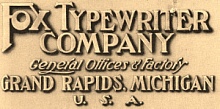 |
 |
 |
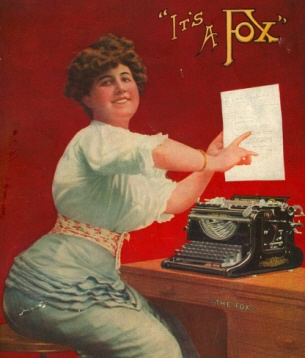 |
| Variations in the Fox Visible. At left, cover art from a 1908 trade catalog courtesy Ed Neuert. Right, William R. Fox, president of the Fox Typewriter Company until retirement from that firm in 1915. Former partner and co-inventor of the old blind writer Fox, Glenn J. Barrett had left Fox for the Union Typewriter Company after appearance of the Fox Visible machines. |
| Fox Typewriter Co. facilities at Grand Rapids, Michigan including general offices and manufacturing plant. Courtesy Ed Neuert. |
| When introduced in 1906, the Fox Visible had no back-spacer and also had no tabulator. Two basic models were offered; the No. 23 which had 39 keys (typing 78 characters) and the No. 24 which had 44 keys (typing 88 characters.) |
 |
| Our first illustration (from Peter Weil) is this April, 1907 cut showing the No. 24. It is notable in that it shows 43 rather than 44 keys. It is not known if any of these were actually built; however, the No. 23 always had 39 keys. |
 |
| On the right, Jim Dax's No. 23 machine, serial 0297 16297. Although a No. 23 it matches all other pertinent details of the illustration seen above. |
 |
| Ed Neuert has sent us several catalog and ad scan sets; the first set is from 1908. Here we see the Fox No. 23 as shown in the 1908 catalog. Immediately notable is the button in the front frame, on the left. This is the operating button or key for the tabulator. Note that it does not appear on the illustrations seen earlier. This excellent illustration will provide good reference for students of the Fox Visible machines, as will our next several. |
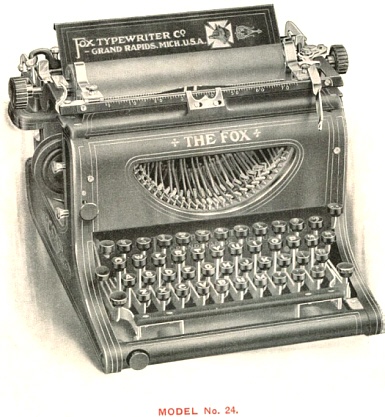 |
| On the right, from the same 1908 catalog is the Fox No. 24. In this view the machine has 44 keys, as it would for the rest of production. Note again the tabulator key in the front frame. |
 |
| At left, we see a wide-carriage Fox Visible, a No. 28. When fitted with carriages of non-standard size the model of the typewriter changed to correspond with the carriage fitted to the machine at the factory. Various models of 1908: No. 23 and 24: Paper width 9.5 inches, writing 7.5 inches No. 25: Paper 12 inches, writing 9.5 inches No. 26: Paper 14.5 inches, writing 12 inches No. 27: Paper 16.5 inches, writing 14 inches No. 28: Paper 19 inches, writing 17 inches Wide carriage machines had the keyboard of the No. 24. Note the full decimal tabulator keys below the front frame. This setup is similar to one patented by Glenn J. Barrett for Union Typewriter and fitted to the Smith Premier several years later. |
 |
| At right, Fox No. 24 illustration from May 1909, sent by Ed Neuert. Note that the machine is not changed from the previous illustration of the No. 24, that it has the tabulator but still does not have a backspacer. |
 |
| At left, Fox No. 24 from David B. Davis collection. Serial number of this machine P1355 21355. Note that it matches the illustration above quite perfectly. |
| Carl Mares' book, published in 1909 gives mention that the Fox Visible machines were just then beginning to be manufactured including a back-spacer mechanism. Quite a number of machines did not have the feature originally, and some added it (Yost Visible for example) while others never did (Emerson, for example.) But we can use a rough date of 1909 for inclusion of the back-spacer to date Fox Visibles. |
 |
| Our next illustration is a 1912 trade catalog illustration from Ed Neuert. Numerous changes were made, although none which made the Fox Visible a "totally new" machine. Note the back-spacer key on the right side of the machine, on the front. Also notable but harder to see is the provision of carriage release on both sides of the carriage; previously it was only on the left. This No. 24 was modified to handle 10.5 inch paper standard. Key levers were lightened at the front, said to give an even lighter touch compared with older Fox Visibles. The machine had a new double-bevel escapement; at some point the two-speed arrangement carried over from the original Fox blind-writers was dropped and this new one subsituted. (The P1355 21355 seen above HAS the two-speed escapement.) New patented ribbon spools with a conical shape were supplied. New two-layer cemented celluloid keytops were fitted, having dished tops for the finger tips. Patents were still pending for these on publication. |
| This 1912 trade catalog again delineates models; note that the 39 key machine is gone from production. In fact, serial numbers of the No. 23 machines stopped at about 36,000 (Fox Visibles run in series, overlapping models together from about 16,000 to about 125,000 which of course correlates to the range 1906 - 1921.) Note that production was said to slow greatly in 1914 according to Typewriter Topics. In 1912 then, the models and variations were as follows: No. 24: Paper 10.5 inches, writing 8.5 inches No. 25: Paper 12 inches, writing 9.5 inches No. 26: Paper 14.5 inches, writing 12 inches No. 28: Paper 19 inches, writing 17 inches Note that one model number is skipped, and that none higher or lower than those listed here appear in the 1912 catalog. Note also that the paper size and writing line length of these newer machines correlates to the previous machines EXCEPT for the No. 24. |
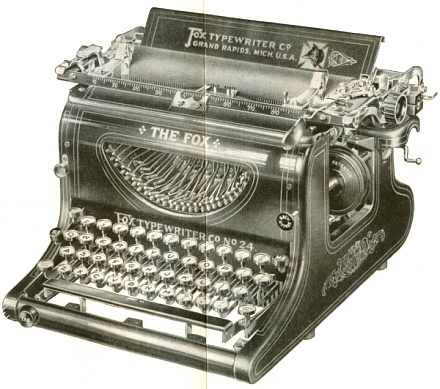 |
| Here is a 1919 illustration, from Ed Neuert. It shows a Fox No. 24, and the most obvious and striking change is that of the keytops. They are now nickel-ringed with white inserts, looking very modern and very like those supplied by other makers for years previous. The exact date of this change is somewhat hard to nail down. Ads as early as 1914-1915 show this change; it is known to occur at roughly serial number 110,000 in production. Other features are very like those of the 1912 machine. |
 |
| Cover of 1919 brochure, from Ed Neuert. |
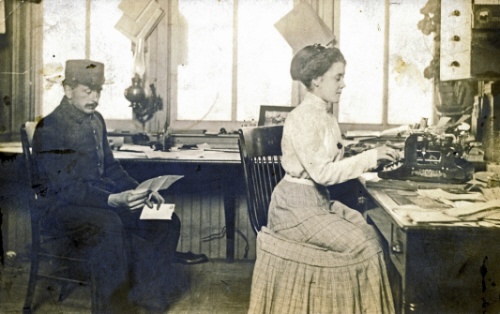 |
| According to Typewriter Topics, the Fox Typewriter Company changed hands with new capital following the retirement of William R. Fox, but continued in production. It soon developed and offered a collapsing portable; it is notable simply from a visual standpoint that the standard Fox Visible was altered to ringed keytops prior to that time, and that all the Fox portables had ringed keytops as well. This makes another good mental note for quick identification regarding rough date of production for the standards. Production ended in 1921 when the company went into receivership, and then liquidation. Note that production of the standard machines from roughly the 1914 or perhaps 1915 appearance of the ringed keytops at about serial 110,000 only went on another 15,000 machines over the next six or seven years. However, portables in three models (eventually, that is) which began in 1917 and ended at the same time were apparently built to a total of about 13,000 machines (in their own separate serial number range, starting at 0) over this same time. Obviously a heavy emphasis was placed on the portable -- perhaps wise, considering the higher profit margin on that machine. Quite a number of patents were filed over time for the Fox Visible, and a number of these mention the aim of reducing manufacturing cost. In fact, deletion of the two-speed escapement may have been toward that end. Fox himself filed some final patents before leaving the typewriter end of the business, including two for conversion of the Fox Visible to a slotted segment (two different key lever - type bar actions were considered.) This conversion never happened; perhaps it was thought to be better in the long run to continue with the old, somewhat complicated design and develop the new portables. It should be noted that the Monarch and the L.C. Smith machines continued with separate bearings, although not nearly as good as those in the Fox, and that both sold extremely well everywhere they were available. In any event the portable didn't save the company, and in 1921 the line of standard-sized Fox machines ends. |
| As previously noted on another page, the Fox Visible was a delight to operate. It's a sure thing that the slogan "Light Running Fox" is truth in advertising - and we must remember that there must have been many typists enamored of the machine. Peter Weil sends us this post card illustration, showing the interior of a Michigan Central Railroad depot in about 1907. The Fox Visible on the desk is obviously a very new thing to the world of typewriting. Notation on the card refers to the stenographer as the "terror of the depot." Perhaps this was an early case of gender integration in these parts, or perhaps she truly was a terror. We'll never know. |
| Peter Weil also sends a 1914 photo of a young lady and a Fox No. 24, seen at left. Peter says that this is his favorite FOX photo of them all; we're inclined to agree! Below, an interesting receipt. It is known that some of the last Fox No. 23 machines to be made were labeled not as Fox No. 23 but as RAPID No. 10. The serial numbers suggest that perhaps a thousand or so were labeled like this. The receipt, dated Feb. 10, 1913 is for sale of a "#10 Rapid" serial 35,555. The price is given as $75.00, with a discount "1/3 off" of $25.00. $50 was paid, leaving $25 on credit. This gives a good hint that the remaining machines were not only relabeled but sold as "cut rate" machines in order to get them off the books, since all regular standard machines cost $100.00 or somewhere thereabouts at this time. Receipt courtesy PETER WEIL |